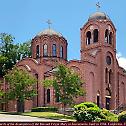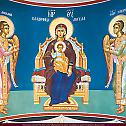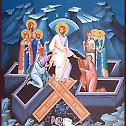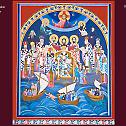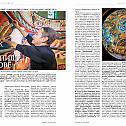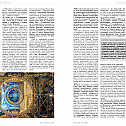The Iconographer of the Centuries
At the time the earliest Serbian immigrant stepped ashore in the New World – in America – that Statue of Liberty, torch in hand, was not there in the New York docks to illuminate the way for the newcomers. The Serbs were received and welcomed by none other than Saint Sava. Who else could it have been? Whom else did they have over there? Saint Sava needed no kind of torch. He is the light and the fire, the lodestar every Serb holds close and dear to heart. And it is no coincidence that the very first Serbian Orthodox Church, erected in California’s city of Jackson in 1894, bears his name.
In 1998, when we immigrated to the City of Sacramento in California, the Church of the Assumption of the Blessed Virgin Mary welcomed us with its gates unfolded. There, we were first greeted, in the name of God and in the name of Saint Sava, by Protopresbyter Miladin Garic, Presbyter Dobrivoje Milunovic, Protopresbyter Stavrophor Bill (William Weir) who was a deacon at the time, and Vladyka[1] Jovan, the Bishop of the Western American Diocese. What’s more, this meeting took place in the church at the Divine Service, the first one I attended in the New World, which also coincided with the Feast Day of the Assumption — the Slava[2] of this church. I was especially touched then, as were many of my fellow refugees, by Vladyka Jovan’s exalted sermon. It resonated in our hearts, beneath the vaults of this temple[3] of ours, which was painted with astonishing frescoes that were unsurpassed by any other in the plethora of churches around the area!
Every summer, all the children from our church in Sacramento travel to Jackson to the Camp Saint Sava for Serbian Orthodox children. Consequently, the Church of Saint Sava in that town, the oldest Serbian Orthodox church in the Western Hemisphere, has become our “other” church. This church had already been painted as well, albeit not in its entirety yet, with frescoes of miraculous splendor and, likewise, by the very same divinely-inspired hand that painted the icons and frescoes of the Sacramento church. So, naturally, I always found myself wondering who could be that artist – the one who transferred us to the timeless realms of prayer by the sheer force of his own divine impetus.
While residing on the estate of the church in Sacramento and tending to the order of the temple in preparation for divine services, I often lingered gazing at the fresco-painted walls and the divine order and peace radiating therefrom. Furthermore, during the divine worship services, I felt as though the main dome’s representation of the Ascension and its centrally placed image of Christ who is bestowing a blessing upon us with both hands, was emanating this very blessing, which then cascaded down the walls upon the depicted saints and overflowed onto the faithful congregation praying to Him humbly while peacefully looking inwards, immersed into the Sacrament of the Sunday Liturgy.
Later on, I learned that the Church of the Assumption of the Blessed Virgin Mary in Sacramento and the Church of Saint Sava in Jackson were painted by the iconographer and seminary graduate Miloje Milinkovic. Moreover, he has worked and is still working in numerous other churches and monasteries, not only in America but worldwide as well. His works adorn the iconostases, the thrones (or cathedrae), and the wall canvases of Orthodox churches, as well as many Orthodox homes. My wish to meet him has been fulfilled at last.
Recently, at the beginning of April but before the corona virus pandemic affected this area, we came to Sacramento to attend the Divine Liturgy and to receive Holy Communion, as it turned out at the last minute, so to speak, that we could be present in church in the customary manner. There, we encountered scaffolding extending across nearly half of the church. The persistent and heavy rainfall, often accompanied with strong wind gusts, had penetrated through the vaulted ceiling, causing damage to many sections of the fresco-paintings. We learned that, upon the invitation of the Church Board, the current Parish Dean Protopresbyter Stavrophor Dane Popovic and Protopresbyter Stavrophor William Weir, the artist had arrived to repair the damages, preferably by Easter. I was delighted and looking forward to the restoration of frescoes, but additionally, I felt the same about the opportunity to meet the iconographer whose work has captured my attention and spurred my admiration for so many years. And to that end, after the Divine Service I found myself sitting in the church hall, facing a man who is modest, withdrawn and a bit timid in the finest and most exceptional sense of the word.
— The Church of the Assumption of the Blessed Virgin Mary in Sacramento is not small nor is it inconspicuous or imperceptible. On the contrary, both the American and the Canadian public became aware of it immediately upon the completion of its construction because it won the first prize of America and Canada for the most exquisite edifice constructed of bricks. Furthermore, that became the main feature of the September/October (1985) issue of the Masonry Design West architecture magazine, titled “The Serbian Church”. There were other numerous prizes awarded to this church for its architectural solutions. It is stated in the chronicles that this is “the first Serbian Church in America, entirely painted by the hand of a single Serbian iconographer.” Personally, I would insert an additional record to the chronicles, stating: the iconographer and seminary graduate Miloje Milinkovic, modern-day Michelangelo, as he is indeed referred to by America’s leading art critics.
Miloje Milinkovic: It is true that this was the first church in America, which I fresco-painted. To this day I remember standing beneath the magnificent unpainted dome of the church and its striking white vaults, on the first day of my first arrival to America in December of 1986. Everything was white! Surprisingly, I had no “fear” whatsoever whilst facing the monumental work that was ahead of me. I felt that my teachers and mentors were all standing right behind me, starting with the earliest ones from the days I enrolled in the Belgrade Theological Seminary in 1973. These tutors whose presence I felt included Professor Misa Mladenovic, whose group iconography classes I attended in addition to the mandatory subjects at school; next, Protodeacon Marko Ilic, academic painter and iconographer, by whose side I studied from 1980 to 1983, not only the icons painted on wooden panels, but also the mysteries of creating icons on the wall surfaces of a church – the painting of frescoes; and all the way to those in Greece and the famous Athonite master teacher – Protomaster iconographer Fr. Arsenios – with whom I worked on refining and perfecting the “ropes of the trade.” After three years of all-comprehensive studies in Greece (1984-1986), and with the prayerful invocation of the Holy Spirit, he gave me the blessing to work independently.
— So this was in essence your diploma of the Master in icon painting?
Miloje Milinkovic: Yes, that was official and held great significance to me personally, but in my view, my diploma was “signed” by Patriarch German of Serbia. Upon my return to Belgrade, he received me as a personal guest at the Patriarchate on May 21, 1986, where I delivered to him the intended gift. And this is how all that transpired. Shortly before my return to Serbia, in the last weeks of the Great Lent on the Holy Mountain[4] of Athos, I had been painting the icon of Christ Pantocrator in the monastery’s studio, which is a venue of life-giving inspiration. I put in my all into that piece of work – all my Christian love and all my previous knowledge (to date) – into that icon, which was intended for Patriarch German as a token of my deep respect and gratitude. It was under his blessing that I even went to Greece for further development and mastery, and wound up in the midst of famous Athonite iconographers. Therefore, my only reciprocal gift, as I deemed it, could be an icon of the Almighty. And so, that was the gift I mentioned, which I gave to Patriarch German. The manner and the reverence with which he received that icon was a confirmation that I had justified his confidence and duly acquired the title of the Master of iconography. That particular icon is now located at the Patriarchate in Belgrade, in the ceremonial, receiving hall for high dignitaries.
— Then, upon the blessing and the recommendation of Patriarch German, you founded and headed the icon studio Seraphim which is now considered to be one of the world’s prestigious iconography workshops, and you are one of the most highly esteemed iconographers of Serbian churches and monasteries in and outside the homeland. Your first official commissioned work in Serbia was at the Annunciation Monastery in Divostin near Kragujevac, followed by the painting of frescoes in the church of Saint Demetrius in Lazarevac. This took place during the summer and fall of 1986, and then, towards the end of the same year, you “sailed across the ocean” and, here, you happened upon the white walls of our relatively young church in Sacramento, consecrated in 1984.
Miloje Milinkovic: I fresco-painted the Church of the Assumption of the Blessed Virgin Mary over the time period spanning from 1986 to 1995. That is to say, over a ten-year period, during which there were pauses that were agreed upon as I was simultaneously engaged in painting frescoes and iconostases in Serbia and in Europe.
— Here in California, you have also created a “holy bridge,” so to speak,
between this church in Sacramento and the Church of Saint Sava in Jackson. It is quite rare, even for America which can be full of surprises, to have such significant works of the same artist located relatively close to one another.
Miloje Milinkovic: I carried out the painting of the fresco program in Jackson’s Church of Saint Sava over the time period between the years 1995 and 2008. In addition, this was a distinctive challenge. Considering that the said first Serbian Orthodox church in the Western Hemisphere was constructed with the modest means of poor Serbian gold miners, it was built following the simplest construction plan. It is comprised of the altar apse and the bell tower alone, but no semi-cylindrical vaults, arches and other common features of the wall structures in our church buildings. For those reasons, the fresco-painting herein, necessitated a distinct approach, inspirited labor, and additionally, much more experience, endeavor, and time.
— Within the entire iconographical program of themes, besides the Great Feasts and other customary representations, there are three distinguishable compositions of particular uniqueness.
Miloje Milinkovic: Yes. The first one is the ktitorial composition, which depicts Saint Simeon, the primogenitor of the sacrosanct lineage of the Nemanjic Dynasty and the forefather of patronage, followed by the builders of the Church of Saint Sava from 1894, as well as a multitude of clergymen who had nurtured and cultivated the soul of the Serbian people. The second one is the Serbian Unification Under the Guidance of Patriarch Pavle, which is one of the most significant events in the entire history of the Serbian Church and the Serbian people, and it is furthermore an icon, I would say, telling the story of this Patriarch’s miracle. The third composition, referred to as The Return of Archimandrite Sebastian Dabovic to America, depicts the transfer of his honorable relics from the Monastery of Zica to Jackson, which were received by Vladyka Maxim and other hierarchs on September 1, 2007.
— You were the first Serbian iconographer who painted icons depicting the images of Bishop Mardarije of America and Canada and of Archimandrite Sebastian, first in America’s church of the Assumption in Sacramento back in 1994, and later followed this practice in other churches. The same applies to the entire Serbian Orthodox Church, notwithstanding that their official canonization ensued much later, in the year 2015.
Miloje Milinkovic: Bishop Irinej (Dobrijevic) of the Eastern American Diocese, who was a hierodeacon at that time and has since become a hierarch of the Serbian Orthodox Church, was the one who gave me the idea to paint the icons with their images. With regard to such ideas and the creative freedom in my work, I must underscore, with pleasure and gratitude, that I enjoyed the unreserved support of the renowned Vladyka Sava (Vukovic) of Sumadija. Incidentally, he was the one who, by virtue of his then-office of Hierarch in the Western American Diocese, gave me the recommendation and the subsequent blessing in 1986, ahead of beginning the works in Sacramento. He subsequently supervised, carefully and meticulously, my work in this church for three years, that is, from 1986 to 1988, during the course of his episcopal jurisdiction in the Diocese.
— There is an anecdote relating that you have surpassed your own
expectations of success and reached or rather ascended to its unfathomable heights precisely through painting over one thousand holy images in this church. Specifically, back in 1997, journalist Stanivukovic composed an article titled “To One Thousand Saints by Elevator,” published in Belgrade’s newspaper Novosti, therein reflecting exactly the catapult of one talented beginner to the highest realms of top-notch artistic stars, to the heights hosting the most outstanding iconographers.
Miloje Milinkovic: That was an article about my work in Sacramento and I must say that I am thrilled that Vladyka Sava had the opportunity to read it. I stated at that time that Vladyka Sava Vukovic, Bishop of Sumadija, was the most deserving man for my success. He gave me exceptional support at the opportune time for my progress, at the very threshold of my independent work, and with astonishing confidence in an iconographer who had just come of age professionally; and that success did come to fruition. Vladyka had enormous prestige, and, accordingly, the power that he used fiercely for everything that could serve the common welfare. And yet his help to me personally was so great that I would later on, and rightfully so, state often and aloud with gratitude, that I had arrived amidst the company of famous iconographers by the elevator whose door was opened by Vladyka Sava. I recall with joy the instance when he, as a member of the Holy Synod of the Serbian Orthodox Church, entrusted me specifically with the task of rendering the cover icon for the Church 1998 calendar, which was in preparation for the occasion of the 800th anniversary of the Hilandar Monastery.
— When recommending a seminary student to be your assistant in the
iconography of the Saint Sava Monastery in Libertyville, Vladyka Sava said to you: “That one won’t embarrass you.” He was known to use this byword on occasion as an attestation that his endorsement was fitting and proper as well as to demonstrate his confidence in the person he was endorsing or recommending.
Miloje Milinkovic: I do believe that the remarkable hierarch, Vladyka Sava, used to say: “That one won’t embarrass us,” while deciding, together with other pertinent figures in the Church, to entrust me specifically with icon and fresco painting of some of our largest churches. That was the governing thought that steered me to give it my all in my assignments, and also to strive so that, in the end, my work may be spoken of in the sense of the epic poetry verses: “All was holy, all was honourable and fitting in the eyes of God.”[5]
— Your studies at Holy Mount Athos, your works all over the Orthodox
Christian world, the grandiose deeds of fresco-painting churches, magnificent iconostases and icons, have all translated into major and well-deserved awards and accolades. I recognize it must be difficult, but could you single one out for us?
Miloje Milinkovic: Personally, I was especially honored by the bestowed acknowledgment in the concluding section of the International Scientific Symposium on the occasion of the 1700th anniversary of the Edict of Milan, which took place in Nis, May 31 – June 2 of 2013. On that occasion, I became a regular member of the Institute for National and Religious Studies from Thessaloniki. The fact that His Holiness Patriarch Irinej of Serbia is an Honorary President of this Institute speaks to its significance in and of itself. The Gramata[6] was conferred to me by the University Professor and the President of the Institute, Dr. Athanasios Angelopoulos, whereby they honored me with recognition as an expert who would have a prominent role in the Department of Iconography and Ecclesiastical Art altogether.
— On July 15, 2014, Patriarch Irinej of Serbia opened the photograph
exhibition “Orthodoxy in America” at the National Ethnographic Museum in Belgrade. This event created an opportunity for a large number of people to get acquainted with your work, albeit and understandably so, through photographs, which were created by the Fine-art photographer Larry Angier from California. How did that collaboration come about?
Miloje Milinkovic: When the famous American master of artistic photography, the “photographer of American rural areas,” entered our church of the Assumption of the Blessed Virgin Mary in Sacramento for the first time, he was amazed by the frescoes I had rendered. He instantaneously became a “lifelong prisoner of their beauty,” as he expressed it. Soon afterward, he photographed the beginning of my work at the Church of Saint Sava in his hometown of Jackson, and he continued to follow the painting of that church over the years. Watching him immerse himself professionally and lovingly into his work, I asked him to visit and record all the churches in America, which I had painted, and this resulted in the creation of impressive and also historical documentation for the Serbian Church.
— Then you became his baptismal Kum (Godfather). Larry was baptized by our good Priest Marko Bojovic from Jackson, and on this occasion Larry received the name Lazar as his baptismal name.
Miloje Milinkovic: About ten years ago, Larry expressed a wish to visit Serbia and I invited him to be my guest. That was his first time to leave America. We went on a tour of our most important monasteries such as Studenica, DJurdjevi Stupovi, Sopocani, Moraca... In the years to follow, after several visits to our holy places throughout the Serbian lands, that is, Serbia, Montenegro, and Bosnia, not only did his outlook on life change but he also expressed a wish to convert to the Orthodox Faith. He asked me to be his Kum (Godfather) at his baptism. So, that’s the way it went. And thanks to my Kum Lazar, the photographs of our churches, frescoes and icons went out into the world, in the highest quality and in the best possible way, and were presented to prestigious magazines, calendars, and monographs of America and Europe.
— Bishop Maxim of the Diocese of Western America was the editor of a
magnificent book — The Serbian Christian Heritage of America Monograph.
Miloje Milinkovic: I am very glad to have contributed to this Monograph of historical significance for our Church. Included within are my icons and frescoes, photographed by my Kum Lazar.
— Your lengthy stay on Holy Mount Athos, in the peace of the Burazeri Cell of the Hilandar Monastery, must certainly be an unparalleled, once-in-a-lifetime experience that left the greatest, ever-lasting impression upon you.
Miloje Milinkovic: While living and studying in the Athonite surroundings, I not only absorbed the knowledge and experiences of monastic iconographers, but also observed the wonderful examples of the utmost spirituality of their ascetic life, so that as time went on, I viewed them more and more as iconographers who portrayed the saints, while, as I saw it, they themselves bore a resemblance to those saints. I believe that I speak correctly when I say that something of that kind, as the fruit of the sublime coalescence of prayer, work and location, can be witnessed and experienced only on Holy Mount Athos, and even there only after a very long presence in that monastic state.
* * *
There is one more composition in the Church of Saint Sava in Jackson, which can be singled out, even though it can be found in other churches, but this one has been reworked, so to speak, and has a contemporary air to it; furthermore, this one bridges the centuries. Namely, “The Exaltation of the Holy Cross” is painted, in its major features, according to the example of older solutions or prototypes. By adding to this composition the images of two hierarchs – Vladyka Grigorije, the first Bishop of Western America and Vladyka Jovan, who blessed the fresco-painting of the church in November, 1995 – the iconographer has connected that old representation, depicting an event that took place in the 4th century, to our very modern day, the second half of the 20th century. “By doing so, I emphasized the unceasing celebration through the centuries of the Holy Cross in the Orthodox Church,” states Milinkovic.
* * *
The Gramata of Bishop Sava (Vukovic) of Sumadija, No. 1041, dated December 26, 1994, was written in a crystal clear fashion in Kragujevac, a decade after the first completed works of iconographer M. Milinkovic. It points out the brilliant vision of that wise hierarch to lend support to then-beginner and now a world-known and esteemed iconographer:
TO WHOM IT MAY CONCERN
Mr. Miloje Milinkovic, a seminary graduate and artist, has made himself available to us immediately upon the completion of his art studies in Greece. He has painted exceptionally the surfaces entrusted to him in the Diocese of Sumadija, in the following locations: the Divostin Monastery, the church in Lazarevac, and the Cathedral Church in Kragujevac, 1250 square meters in total. We would like to take this opportunity to emphasize that we our doubly satisfied with his work.
Wherever he worked, he completed the painting of icons and frescoes to universal satisfaction, and we, therefore, consider him to be one of our best painters in the Fatherland. Secondly, we identify him as a man who can serve as an example to be followed by many others.
* * * * * * * * * * * * * * * * * *
*The interview with iconographer Miloje Milinkovic was conducted by journalist Nebojsa Tosic, and it was published in the Canadian magazine SLOVO, April, 2020.
The photographs accompanying the text were taken by Fine-art photographer Lazar Larry Angier.
Source: Magazine SLOVO, Kitchener, Canada, April 28, 2020.
[1] Informal for Bishop. (Translator’s Note).
[2] Patronal Feast day of a church, the day a church celebrates its patron saint (Translator’s Note).
[3] Terms church and temple are used interchangeably hereafter; have the same meaning (Translator’ Note).
[4] Also known as Athos, Mount Athos, Holy Mount Athos. Shall be referred to hereafter as Holy Mount Athos. (Translator’s Note).
[5] Translator’s Note: Translation of the poetry from: Hatoo A.T. (ed.) Traditions of Heroic and Epic Poetry. Vol.1:199, The Traditions. London: The Modern Humanities Research Association, 1980.
[6] In this case gramata means certificate or decree. (Translator’s Note).

